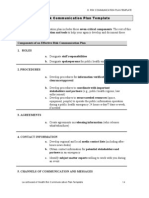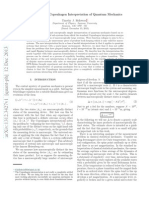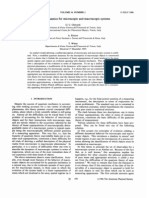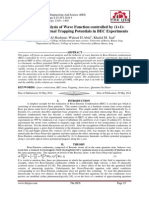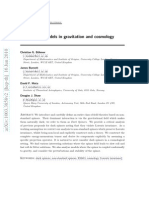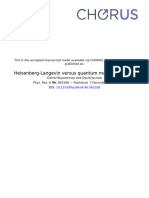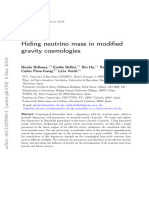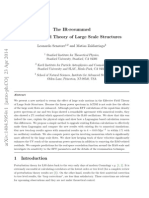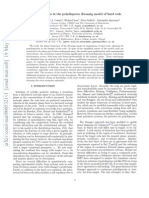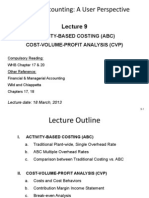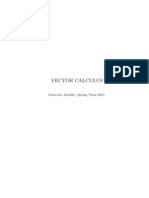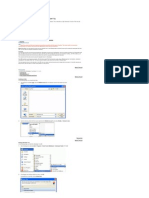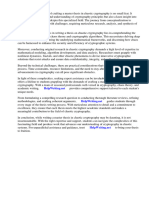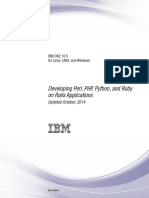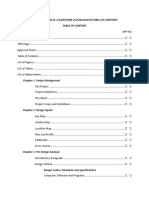Local Realism of Macroscopic Correlations: Electronic Address: Phykd@nus - Edu.sg
Local Realism of Macroscopic Correlations: Electronic Address: Phykd@nus - Edu.sg
Uploaded by
Shweta SridharCopyright:
Available Formats
Local Realism of Macroscopic Correlations: Electronic Address: Phykd@nus - Edu.sg
Local Realism of Macroscopic Correlations: Electronic Address: Phykd@nus - Edu.sg
Uploaded by
Shweta SridharOriginal Description:
Original Title
Copyright
Available Formats
Share this document
Did you find this document useful?
Is this content inappropriate?
Copyright:
Available Formats
Local Realism of Macroscopic Correlations: Electronic Address: Phykd@nus - Edu.sg
Local Realism of Macroscopic Correlations: Electronic Address: Phykd@nus - Edu.sg
Uploaded by
Shweta SridharCopyright:
Available Formats
Local Realism of Macroscopic Correlations
R. Ramanathan,
1
T. Paterek,
1
A. Kay,
1, 2
P. Kurzy nski,
1, 3
and D. Kaszlikowski
1, 4,
1
Centre for Quantum Technologies, National University of Singapore, 3 Science Drive 2, 117543 Singapore, Singapore
2
Keble College, Parks Road, Oxford, OX1 3PG, United Kingdom
3
Faculty of Physics, Adam Mickiewicz University, Umultowska 85, 61-614 Pozna n, Poland
4
Department of Physics, National University of Singapore, 2 Science Drive 3, 117542 Singapore, Singapore
(Dated: October 12, 2010)
We show that for macroscopic measurements which cannot reveal full information about micro-
scopic states of the system, the monogamy of Bell inequality violations present in quantum mechanics
implies that practically all correlations between macroscopic measurements can be described by local
realistic models. Our results hold for sharp measurement and arbitrary closed quantum systems.
I. INTRODUCTION
The notion of local realism posits that measurable properties of physical systems exist before measurements are
performed, and that relativistic causality holds. This point of view was brought to the attention of the physics
community in the famous paper by Einstein, Podolsky and Rosen in 1935 [1], where it was argued that quantum
mechanics is an incomplete theory in need of further renement to bring it in line with local realism. In 1964, John
Bell used astonishingly simple reasoning in the form of an algebraic inequality (Bell inequality) to demonstrate that
local realism is in contradistinction with the predictions of quantum theory [2]. His ndings have been conrmed
in numerous experiments in which various loopholes, which potentially still allow a local realistic description of the
measured data, were closed individually [38]. Although there is still no conclusive experiment closing all the loopholes
at the same time, most scientists think that on the microscopic scale the world is not local realistic.
The macroscopic world we experience, to the contrary, is described by classical physics; a local realistic theory.
One of the most fundamental questions one can ask is how a local realistic macroscopic world emerges from the
microscopic scale, on which level it cannot be described by local realism. A number of resolutions to this question
have been suggested. The more radical ones, the so-called collapse models [914], predict that quantum mechanics will
fail for suciently complex systems. Another approach is to look for classicality as a limit of quantum phenomena.
The decoherence programme derives the lack of superposition of the pointer state of the measuring apparatus from an
inevitable interaction between the quantum system and its environment, see for instance Ref. [1517]. A conceptually
dierent approach focuses on the limits of observability of quantum eects in macroscopic objects [1821].
The steady progress in experimental techniques allows one to perform measurements that were considered infeasible
decades ago. Experiments have reached a level of sophistication where several spins can be manipulated coherently
for suciently long times to perform small quantum computations [22]. In spite of this tremendous progress, one
still faces a formidable challenge to manipulate systems consisting of a macroscopic number, perhaps of the order of
10
23
, of particles. Although one cannot exclude such a possibility in the future, at the present moment it is simply
an experimental impossibility.
The purpose of this paper is to consider the nature of the correlations that we can reasonably measure on these
macroscopic systems with existing experimental capabilities, showing that if the number of measured particles is
large enough, a local realistic description emerges, regardless of the quantum state of the system. The intuition
behind this result is that macroscopic measurements do not reveal the properties of individual particles, and quantum
correlations are monogamous [2329] while the classical correlations are not. In fact, we provide answers to two subtly
dierent questions, necessitating two dierent approaches. These two questions are, in eect Why does nature appear
classical in the macroscopic limit? and Why does quantum mechanics appear classical in the macroscopic limit?.
The distinction arises because, to date, while we have overwhelming conrmation of quantum mechanics for the
sets of observables that we can access in the lab, there are certainly correlation functions of macroscopically large
systems, such as the systems we will examine in this paper, that have never been tested for conformance to quantum
mechanics; it is possible that nature functions quantum mechanically in experimentally accessible observables, but
behaves dierently on these scales. Hence, we make a distinction, although we will see that it does not signicantly
aect the conclusions.
Electronic address: phykd@nus.edu.sg
a
r
X
i
v
:
1
0
1
0
.
2
0
1
6
v
1
[
q
u
a
n
t
-
p
h
]
1
1
O
c
t
2
0
1
0
2
II. MACROSCOPIC MEASUREMENTS AND LHV MODELS
In order to precisely dene our concept of macroscopic measurements, consider systems of many qubits. This
is often a good approximation to systems composed of magnetic materials and metals [30]. We are interested in
experimentally feasible measurements performed on macroscopic regions of the system whose results can be known
with arbitrary precision. The simplest measurement of this kind is magnetization along some direction, which is the
average projection of all spins on the given direction. The outcome of this measurement does not reveal information
about the spin projections of individual particles; there are many congurations of individual spin projections that
give the same magnetization. The situation is therefore analogous to statistical mechanics, where one macrostate is
realized by the averaging over an enormous number of microstates.
Magnetization observables are described by one-body operators that can be written as
k
n
k
, where
k
=
(
x
,
y
,
z
) are the standard Pauli operators acting on the kth particle and n is a 3 component vector of unit length.
One could also consider M-body observables that read
, where contains all dierent subsets of M particles
and O
is an arbitrary M-qubit Hermitian operator. These are increasingly hard to implement experimentally with
increasing M (or to extract from the measurement results of single-body operators, as would be the case with the
variance, which is a two-body operator). For this reason, we focus on magnetization measurements as the most
feasible scenario and later we extend our considerations to the case of M-body measurements to show that they do
not change the central thesis of this paper, up to some high M threshold.
We investigate a lattice of macroscopically many qubits, N 10
23
, prepared in some state , and will prove the
existence of a local hidden variable model for the correlations between magnetization measurements on macroscopic
regions of these qubits. As an illustration, consider dividing the lattice into two disjoint regions A and B, as depicted
in Fig. 1, containing N
A
, N
B
qubits respectively, where N
A
, N
B
are of the order of N. In each of the regions, we
perform a measurement of local magnetizations M
a
(M
b
) along some directions a (
b):
M
a
iA
a
i
and M
jB
b
j
. (1)
Quantum correlations between the magnetization measurements in the state , E
a
b
= M
a
M
, are given by the
sum of microscopic correlations between all pairs of qubits from dierent regions:
E
a
b
=
iA
jB
Tr
_
(a
i
b
j
)
_
. (2)
Since the very same measurements are performed on all the microscopic pairs, the macroscopic magnetization corre-
lations are eectively described by the averaged state of two qubits:
E
a
b
= N
A
N
B
Tr
_
(a
b )
AB
eff
_
, (3)
where the eective two-qubit state is described by the positive semi-denite operator
AB
eff
=
1
N
A
N
B
iA
jB
ij
, (4)
and
ij
is the reduced density matrix for ith qubit at A and jth qubit at B. These dierent expectation values
can then be combined together using coecients (a,
b) for the S
A
, S
B
dierent measurement settings on Alices and
Bobs partitions respectively, to give what we refer to as a macroscopic Bell parameter:
B =
a,
b
(a,
b)E
a
b
.
A set of correlations E
a
b
admits a local hidden variable model (LHV) if there are parameters , distributed with
probability density (), and local response functions J
A
(a, ) and J
B
(
b, ) such that
E
a
b
=
_
d()J
A
(a, )J
B
(
b, ). (5)
Applied to our scenario a set of quantum correlations E
a
b
admits an LHV model as soon as we can construct such
a model for correlations obtained from the eective state
AB
eff
. Therefore,
AB
eff
will always be the focus of our study.
3
FIG. 1: Measurements of local magnetizations on a macroscopic object. The arrows represent directions of magnetization
measurements in macroscopic regions A and B. Each microscopic qubit in a given region is measured along the same direction.
The correlations between magnetization measurements are determined by the eective two-qubit state
AB
eff
being the uniform
average over all reduced density matrices ij. The monogamous nature of quantum correlations limits the strength of correlations
contained in the states ij and
ij
because they share the common qubit i.
Note that whatever results we succeed in deriving regarding a set of states which do not violate some class of
macroscopic Bell inequalities, will apply equally to the class of states (
N
A
i=1
U
A
i
N
B
j=1
U
B
j
)(
N
A
i=1
U
A
i
N
B
j=1
U
B
j
)
for
measurement settings U
A
i
(a )U
A
i
and U
B
i
(
b )U
B
i
under the same conditions. For instance, if we prove that no
state violates a set of Bell inequalities, this instantly generalizes to Bell inequalities which allow for some variation
of magnetic elds over the sample.
III. EXPLICIT MODELS AND QUANTUM COMPLEMENTARITY
In this section, we will show that
AB
eff
admits LHV description for two magnetization measurements performed on
up to log
2
N macroscopic regions. Our proof will proceed by utilizing the quantum character of the magnetization
measurements, but makes no assumption on the behavior of correlations which do not enter magnetization outcomes
(which may have never been proven to behave quantumly).
A set of four correlations measured on a two-qubit state with one of two local observables admits an explicit LHV
model of Ref. [31] if elements of the correlation tensor T
kl
= Tr(
k
l
) satisfy [31]:
L
k,l=x,y
T
2
kl
1, (6)
where orthogonal local directions x and y are dened to be along sum and dierence of the two local setting vectors.
Note that this condition does not require orthogonal measurement settings in a Bell experiment.
We apply this condition to the eective state
AB
eff
. The elements of its correlation tensor read
T
kl
=
1
N
A
N
B
iA
jB
T
(ij)
kl
, (7)
where T
(ij)
kl
is the component of the correlation tensor for particles i and j in the regions A and B respectively.
Substituting into (6) gives
L =
1
N
2
A
N
2
B
i,i
j,j
T
(ij)
T
(i
)
, (8)
with
T
(ij)
= (T
(ij)
xx
, T
(ij)
xy
, T
(ij)
yx
, T
(ij)
yy
). In the next step, we write L as a combination of vectors
P
(ij)
=
(T
(ij)
xx
, T
(ij)
xy
, T
(i(j+1))
yx
, T
(i(j+1))
yy
) and
Q
(ij)
= (T
(i(j+1))
xx
, T
(i(j+1))
xy
, T
(ij)
yx
, T
(ij)
yy
), the components of which are expectation
4
values of mutually anti-commuting operators:
L =
1
2N
2
A
N
2
B
i,i
j,j
B
_
P
(ij)
P
(i
)
+
Q
(ij)
Q
(i
)
_
. (9)
The components of vectors
P
(ij)
and
Q
(ij)
involve correlations between two pairs of micro-systems, pair (ij) and
(i(j +1)), i.e. the sum is modulo N
B
. The monogamous nature of correlations between these pairs, which stem from
quantum complementarity, limits the lengths of
P
(ij)
and
Q
(ij)
below one [29], and consequently gives L 1. Thus
we have shown that the correlations between local magnetizations in the system of N qubits are of classical nature
as long as N
A
or N
B
is greater than one. In eect, the quantum correlations get diluted in the eective state
AB
eff
due to monogamy between the dierent pairwise terms, which themselves arise because the observables see the whole
quantum state as an equal average over all possible pairs of qubits between regions A and B.
We generalize this method to the scenario where the system of N qubits is partitioned into K regions such that
there are N
k
, of the order of
N
K
, particles in each region, with k = 1, . . . K. We prove in Appendix A that when
K log
2
(N) there is always an LHV description for all quantum states . We stress that the bound on K may not
be tight and even more macroscopic observers may still not be able to violate a Bell inequality.
The method can also be extended to the scenario where one measures M-body observables (for example, magne-
tization is a 1-body observable and magnetic susceptibility is a 2-body observable), and consequently considers Bell
inequalities of 2M-qubit correlation functions. It can be shown using the above methods that in particular CHSH-like
inequalities are not violated by macroscopic systems up to some high threshold M.
IV. BELL MONOGAMY AND LOCAL REALISTIC MACROSCOPIC CORRELATIONS
Now we prove more general results using the stronger assumption that quantum predictions are valid even for
experiments that cannot be performed in practice. In practice, each microscopic constituent of a macroscopic system
cannot be addressed, but we assume that the predictions of quantum mechanics hold true even if they could be
addressed. Our approach closely follows the proof technique in [27] which proved the monogamy of Bell inequalities.
Given the similar nature of proofs in [28], one expects that the results can be extended to discuss why general no-
signalling theories would also appear classical, not merely limited to quantum mechanics. However, we have not
formalised this expectation.
Our additional assumption about the applicability of quantum mechanics permits us to consider a much more
general scenario than the previous section. Let us take a sample of N spins of arbitrary local Hilbert space dimension.
The vector of matrices provides a Hermitian basis for the operators in the local Hilbert space. Partition these spins
into k partitions of N
A
, N
B
. . . N
K
particles respectively. On each of these partitions X, we will be able to choose from
S
X
measurement settings. A given measurement setting will be denoted by i
X
, and the corresponding measurement
outcome by j
X
. We can denote the dierent measurement operators by E
X
i
X
,j
X
, which are POVM elements for a
given measurement setting and outcome. They satisfy a completeness relation
j
E
X
i,j
= 11. So, we can write a rather
generic Bell inequality (which includes those previously dened as a subset) in terms of
B =
i,
j
(
i,
j)Tr
_
AB...K
eff
(E
A
i
A
,j
A
E
B
i
B
,j
B
. . . E
K
i
K
,j
K
)
_
where
i is a vector of the measurement settings i
A
. . . i
K
and
AB...K
eff
is similarly dened to
AB
eff
, i.e.,
AB...K
eff
=
1
N
A
N
B
. . . N
K
aA...kK
a,b...k
.
Now we will show that the following quantum probability distribution
p(
i,
j) = Tr
_
AB...K
eff
(E
A
i
A
,j
A
E
B
i
B
,j
B
. . . E
K
i
K
,j
K
)
_
,
admits a LHV model. This can be done provided the number of measurement settings, S
X
, is equal to the number
of spins in the partition, N
X
for all X {A, B. . . K}. To start, we dene vectors m
X
of S
X
elements, which read
like a script for a deterministic protocol of what measurement results to give provided with a measurement setting:
if the measurement setting is i
X
, element m
i
X
X
is what should be given as outcome j
X
. With this in place, we are in
a position of give the LHV strategy a source of shared randomness between all the parties selects a set of vectors
m
A
, m
B
. . . m
K
with probability
Tr
_
(E
A
m
A
E
B
m
B
. . . E
K
m
K
)
_
(10)
5
where
is any quantum state that has every k-qubit reduced density matrix drawn from one Alice, one Bob etc. is
equal to
AB...K
eff
and where
E
A
m
A
= E
A
1,m
1
A
E
A
2,m
2
A
. . . E
A
S
A
,m
S
A
A
(This is well dened if S
A
= N
A
). Having jointly selected these vectors, then the parties wait until theyre told what
their measurement setting i
X
is, at which point they give the outcome m
i
X
X
. If we use this strategy, the resultant
probability distribution is
p(
i,
j) =
m
A
... m
K
Tr(
E
A
m
A
E
B
m
B
. . . E
K
m
K
)
m
i
A
A
,j
A
. . .
m
i
K
K
,j
K
,
which you will readily see is equal to the desired distribution by using the completeness relations of the POVM
operators. So, this will lead us to conclude that if at least one example of a state
exists, for a given
AB...K
eff
, then
the original state cannot violate a macroscopic Bell inequality of S
A
= N
A
, S
B
= N
B
. . . settings. However, we can
always construct
from . Let
X
be a permutation over all spins of a given partition X. Thus,
=
1
|
A
| . . . |
K
|
A
...
K
(
A
B
. . .
K
)(
A
B
. . .
K
)
.
The result readily extends in two ways. Firstly, observe that in the N
A
measurement settings (for instance), any two
can be set equal to each other, and the result still holds. Thus, in fact, the result holds provided all S
X
N
X
. Secondly,
we can examine many-body observables. For M-body observables, we can redene the eective Bell inequality of
eff
to be over M physical spins in each partition (although this requires that those M-body observables can be applied
to all possible subsets of M spins, whereas one might prefer to impose a locality constraint). This has the knock-on
eect of simply rescaling the limiting number of Bell measurements to N
X
/M, assuming this is an integer. So, a
system of say 10
23
particles divided into 10
7
partitions, and involving 10
7
-body observables would still require at least
10
9
measurement settings to possibly measure some violation of a Bell inequality, which we consider infeasible.
In order to reach this result, we were required to calculate the probabilities in Eqn. (10), which are probabilities
dened beyond the limit up to which quantum mechanics has been tested. This is why we have made the distinction
between the two derivations; that of the previous section did not require this assumption. However, in some sense,
this is not required here either. The probabilities of Eqn. (10) can be just that, probabilities devoid of further physical
interpretation. Thus, even though the physical specimen that we are measuring may not be in the quantum state
and these expectation values do not actually exist, all we need to know is that the set of measurements that we
can perform appear quantum mechanical. If they indeed appear so, they must appear as if they were originating
from some quantum state (if there were no quantum state compatible with all the measurement results, we would
conclude that the system is not behaving quantumly). Thus, we can use the mathematical formalism of quantum
theory to manipulate this hypothetical and give us the LHV.
This no-go theorem gives a very strong bound on the degree of control we would need over large systems for there
to possibly be a violation of a Bell inequality. Indeed, it is quite tight since it says that for two parties with N
A
= 1
and N
B
= 1, 2 with S
A
= S
B
= 1, 2 there cannot be a Bell violation, whereas one can show that there is a violation
for N
A
= 1 and N
B
= 1, 2 with S
A
= S
B
= 2, 3 (the N
B
= 1 case is just CHSH. The N
B
= 2 case uses a 3-setting Bell
inequality found in [32]). Another interesting feature, however, is that there are some classes of states which we can
show will never violate these macroscopic Bell inequalities, no matter how many measurement settings are allowed in
the Bell inequality, as we will see in the following section.
V. ROTATIONALLY INVARIANT SYSTEMS
Stronger results can be proved for restricted classes of N-qubit states , such as those which are rotationally
invariant, i.e.,
= U
N
(U
N
)
, (11)
for all single qubit unitaries U. This is a wide class of physically important states such as thermal states of the
Heisenberg model.
First of all, we notice that any reduced density matrix
ij
obtained from the density matrix satisfying the relation
(11) is rotationally invariant, i.e.,
ij
= U U
ij
U
= V
ij
|
|
ij
+ (1 V )
11i11j
4
[33]. Thus, the eective
6
state
AB
eff
inherits the same property:
AB
eff
= V |
|
AB
+ (1 V )
11
A
11
B
4
, (12)
where
1
3
V 1. It was proven in Ref. [34] that for
1
3
V 0.66 this state admits a LHV description for all
sets of projective quantum measurements. The upper bound on this range can be extended to 2/3 by invoking the
results of [35] within the formalism presented in [34]. It is also known [36] that if p
5
12
, there is no Bell inequality
violation at all, even allowing for POVMs. From our prior description of
AB
eff
, we can say that
V =
1
N
A
N
B
ij
V
ij
and, from singlet monogamy [37], one can prove that
V
R
ab
+ 2
3R
ab
where R
ab
= max(N
A
, N
B
). Thus, provided our sample contains more than two qubits, we can never violate a
macroscopic Bell inequality (of any number of settings) composed of projective measurements. If N
A
or N
B
8,
there are no Bell inequalities whatsoever that can be violated.
VI. CONCLUSIONS
We have studied the conditions under which one can sustain a local realistic description of correlations between
macroscopic measurements. We focused on a large system of spins (N 10
23
) in an arbitrary quantum state. The
system was partitioned into k 2 regions, each containing a number of qubits of the order of
N
k
. In each region, a
measurement of magnetizations in several randomly chosen directions was considered.
We concluded from Sec. III that for two-setting Bell inequalities on a total of N qubits divided into two partitions,
where each setting is just a local magnetic eld direction across all spins of a partition, nature (which could possibly
contain some post-quantum correlations which are hidden from the measurements that we can directly make) admits
a LHV description. In the appendices, we will justify that these results continue to hold when we further divide the
partitioning such that there are up to log
2
(N) parties, and for many-body observables, although the exact threshold
for the extent of these many-body operators will be presented in a subsequent publication.
In contrast, in Sec. IV, we saw directly the possible trade-o between number of parties, extent of the many-
body interactions and number of measurement settings traded o, at the expense of having to assume that quantum
mechanics is valid beyond where it has been experimentally tested. This trade-o is that if any party can utilise a
number of settings which is greater than the ratio of the number of particles in the partition to the extent of the
many-body correlations measured, a Bell inequality can potentially be violated. However, given the huge number
of particles involved in real systems, implementing this requires a thoroughly absurd experiment. Thus, quantum
mechanics appears to produce classical correlations in the macroscopic limit as a result of our experimental limitations.
When viewed as a no-go theorem for the visibility of quantum correlations over and above classical correlations,
the interesting direction for future study is to consider sets of measurements which could be implemented but are not
covered by the proofs here. It would also be interesting to see if we can construct results which involve many-body
operators which are necessarily local on some underlying lattice.
VII. ACKNOWLEDGEMENTS
This research is supported by the National Research Foundation and Ministry of Education in Singapore. We
acknowledge useful discussions with M. Paw lowski. T. P. acknowledges discussions with J. Koer and
C. Brukner, D.
K. would like to thank A. Ekert, R. Fazio, V. Scarani and A. Winter for stimulating discussions.
[1] A. Einstein, B. Podolsky and N. Rosen, Phys. Rev. 47, 777 (1935).
[2] J. Bell, Physics 1, 195 (1964).
7
[3] A. Aspect, P. Grangier, and G. Roger, Phys. Rev. Lett. 47, 460 (1981).
[4] A. Aspect, J. Dalibard, and G. Roger, Phys. Rev. Lett. 49, 1804 (1982).
[5] G. Weihs, T. Jennewein, C. Simon, H. Weinfurter, and A. Zeilinger, Phys. Rev. Lett. 81, 460 (1998).
[6] M. A. Rowe et al., Nature 409, 791 (2001).
[7] A. Aspect, Nature 398, 189 (1999).
[8] P. Grangier, Nature 409, 774 (2001).
[9] F. K arolyh azy, Il Nuovo Cimento A 42, 390(1966).
[10] I. C. Percival, Proc. R. Soc. A 451, 503 (1995).
[11] P. Pearle and E. Squires Found. Phys. 26, 291 (1996).
[12] L. Di osi, Phys. Lett. A 105, 199 (1984); Phys. Lett. A 120, 377 (1987); Phys. Rev. A 40, 1165 (1988).
[13] R. Penrose, Gen. Relativ. Gravit. 28, 581 (1996); Phil. Trans. R. Soc. A 356, 1927 (1998); The Road To Reality (Jonathan
Cape Publishers, London, 2004).
[14] G. C. Ghirardi, A. Rimini, and T. Weber, Phys. Rev. D 34, 470 (1986).
[15] W. H. Zurek, Phys. Today 44, 36 (1991).
[16] W. H. Zurek, Rev. Mod. Phys. 75, 715 (2003).
[17] M. Schlosshauer, Decoherence and the quantum-to-classical transition (Springer, 2007).
[18] A. Peres, Quantum Theory: Concepts and Methods (Kluwer Academic, Dordrecht, 1995).
[19] P. Busch, M. Grabowski, and P. J. Lahti, Operational Quantum Physics (Springer, New York, 1995).
[20] D. Poulin, Phys. Rev. A 71, 022102 (2005).
[21] J. Koer and
C. Brukner, Phys. Rev. Lett. 99, 180403 (2007); Phys. Rev. Lett. 101, 090403 (2008); arXiv:1009.2654
(2010).
[22] L. Vandersypen et al., Nature 414, 883 (2001).
[23] V. Coman, J. Kundu, and W. Wootters, Phys. Rev. A 61, 052306 (2000).
[24] T. J. Osborne and F. Verstraete, Phys. Rev. Lett. 96, 220503 (2006).
[25] V. Scarani and N. Gisin, Phys. Rev. Lett. 87, 117901 (2001); Phys. Rev. A 65, 012311 (2001).
[26] B. Toner and F. Verstraete, quant-ph/0611001.
[27] B. M. Terhal, A. C. Doherty, and D. Schwab, Phys. Rev. Lett. 90, 157903 (2003).
[28] M. Paw lowski and
C. Brukner, Phys. Rev. Lett. 102, 030403 (2009).
[29] P. Kurzy nski, T. Paterek, R. Ramanathan, W. Laskowski, and D. Kaszlikowski, in preparation.
[30] N. W. Ashcroft and N. D. Mermin, Solid State Physics, (Harcourt, Orlando, 1976).
[31] M.
Zukowski and
C. Brukner, Phys. Rev. Lett. 88, 210401 (2002).
[32] D. Collins and N. Gisin, J. Phys. A 37, 1775 (2004).
[33] R. Werner, Phys. Rev. A 40, 4277 (1989).
[34] A. Acin, N. Gisin, and B. Toner Phys. Rev. A 73, 062105 (2006).
[35] A. Tonge, technical report TR/08/83, Low Dimensional Grothendieck constants (1983).
[36] J. Barrett, Phys. Rev. A 65, 042302 (2002).
[37] A. Chandran, D. Kaszlikowski, A. Sen(De), U. Sen, V. Vedral, Phys. Rev. Lett. 99, 170502 (2007); A. Kay, D. Kaszlikowski,
R. Ramanathan Phys. Rev. Lett. 103, 050501 (2009).
Appendix A: Multipartite Scenario
We generalize the method to the scenario where the system of N qubits is partitioned into k regions, namely
A, B. . . K such that there are N
k
particles in each region. Assume for the moment that all N
k
are equal to some n.
Evidently N = n k. The case where the number of particles in each region is dierent will be dealt with later.
Once again, we consider the situation where the local magnetization is measured in each region. The question is
then: Does a state of the system exist such that the correlations between the local magnetizations are non-classical?
We now proceed in a manner analogous to the bipartite scenario. The correlations between local magnetizations
read
M
n1
M
n
k
= n
k
Tr
_
(n
1
n
k
)
R1...R
k
eff
_
, (A1)
where the eective state is now a state between k qubits
AB...K
eff
=
1
n
k
l1A
l
k
K
l1...l
k
constructed from the k-qubit reduced density matrices,
l1...l
k
, between qubits taken one from each region. The
existence of a LHV model for k-qubit correlation measurements in this eective state then implies its existence for
the whole quantum state .
8
We use here the results from Ref. [31], in which it was shown that a set of 2
k
correlation functions obtained on
k-qubit state by measuring one of two local observables admits LHV model if
i1...i
k
={x,y}
T
2
i1...i
k
1, (A2)
where T
i1...i
k
= Tr(
i1
i
k
AB...K
eff
) is the correlation function for the orthogonal local directions x and y dened
as sum and dierence of local measurement settings. In our case, these correlation functions read
T
i1...i
k
=
1
n
k
l1R1
l
k
R
k
T
l1...l
k
i1...i
k
, (A3)
where T
l1...l
k
i1...i
k
gives the correlations between a set of k particles labeled by l
1
. . . l
k
. Inserting this expression into the
LHV criterion yields
2
i1...i
k
=1
T
2
i1...i
k
=
1
n
2k
2
i1...i
k
=1
_
_
l1...l
k
1
...l
k
T
l1...l
k
i1...i
k
T
l
1
...l
k
i1...i
k
_
_
. (A4)
We show under which conditions this expression is less than 1 in order to satisfy the LHV criterion.
This will be accomplished by showing that the expression above can be written as the sum scalar products between
any two of n
k
vectors each of which has length at most one. Note that the sums over i
1
. . . i
k
and the sums over
l
1
. . . l
k
and l
1
. . . l
k
result in a total of 2
k
n
2k
terms in the above expression. Hence, each vector that we construct
must have a minimum of 2
k
components so that the nal expression has magnitude less than 1.
From Ref. [25], we know that if the components of each vector are averages of mutually anti-commuting observables,
the length of the vector is bounded by 1. The task then is to nd n
k
groups of 2
k
correlation functions T
l1...l
k
i1...i
k
such
that the corresponding observables
i1
i
k
mutually anti-commute. This is a generalization of what was done
in the bipartite scenario.
We now present a simple algorithm to accomplish this task. We will rst construct one vector of 2
k
components
and build the other n
k
1 vectors by applying certain modications to it.
For simplicity, we shall rst construct the vector as a set of 2
k
mutually anti-commuting observables and then
replace the observables by the corresponding correlation functions. Note that each component of the vector is a
tensor product of k single qubit observables of the type
ij
acting on one of the qubits l
j
on each region. For each
qubit l
j
in region J, these can take only two values, namely
lj
1
and
lj
2
. These two observables clearly anti-commute
for given l
j
. Since we need 2
k
mutually anti-commuting observables, a simple and direct solution is to construct a
binary tree algorithm which would require N
k
= 2
k1
qubits in a region.
Let us rst briey discuss this approach before proceeding to look for improvements. We rst list all 2
k
strings
l1
1
l
k
1
to
l1
2
l
k
2
. Each of the n
k
vectors should contain all these strings. The dierence between the
vectors will lie only in the values of l
1
. . . l
k
. The simplest approach is to let each l
j
assume values from 1 to 2
j1
.This
can be represented by the tree diagram as shown in Fig.[2] for k = 4.
The remaining vectors are constructed by simple modications to the original vector. Two operations are performed:
1. change of l
j
to l
j+m
where addition is modulo m; and 2. change of i
j
to i
j
+ 1 where addition is modulo 2.
It is straightforward to show that these two operations applied to all operator sequences in a vector preserve the
anti-commutation of operators. Moreover, all the n
k
vectors can be obtained from one vector by applying these two
operations.
Hence, a possible grouping of terms is achieved which ensures that the LHV criterion is satised. The pitfall is
that the algorithm is inecient and needs one of the regions, namely the last one, to have n = 2
k1
qubits. Since we
assume that all regions contain roughly equal number of qubits, we have N = 2
k1
k.
A factor k improvement can be obtained by modifying the binary algorithm as we show below. First let us dene
a function g(n) as the smallest power of 2 that is greater than or equal to n. We then dene m to be g(
2
k1
k1
). We
then carry out the binary tree algorithm for the rst m operators with the leaf at the k
th
region. In the second
step, we shift the leaf of the tree one region to the left and construct the next m operators again by the binary tree
method. Then in the third step, we shift the leaf one region to the left and construct 2m operators. In general, in
the j
th
step, we shift the leaf one region to the left and construct 2
j2
m operators by the binary tree method. We
carry out this algorithm until 2
k
operators are constructed at which point the binary string is exhausted and no more
mutually anti-commuting operators exist. The algorithm thus describes a binary tree that curls back and equitably
distributes the 2
k
operators among the k regions giving at most n =
k
l=1
g(
2
l1
k1
) particles per grid. An illustration
9
FIG. 2: Left: Binary tree construction of 16 mutually anti-commuting operators for k = 4 regions. For convenience 1 (2) has
been labeled as X (Y ). Each branch of the tree represents one operator sequence. For instance the top-most branch represents
1
1
1
1
1
1
1
1
. The number of particles in region J is then n = 2
j1
. Right: A factor k improvement on n can be obtained
by folding the tree at particular operator sequences as explained in the text.
of this construction for k = 4 is given in Fig. 2. As before, other vectors are obtained from the rst one constructed
by applying the two operations previously described.
A more careful reconstruction of the binary tree is possible to give N
k
_
(
2
k2
k1
)
_
. This method therefore, assures
us that given a sample with N qubits, a division into k log
2
(N) regions leads to a LHV model for magnetization
measurements in two-setting Bell inequalities and more partitions are needed in order to violate such inequalities. It
is worth noting that the binary tree method may not be optimal in constructing sets of mutually anti-commuting
operators and in actual fact, the dependence of N on k may be polynomial rather than exponential. One further
point to be noted is that when the number of qubits in each region is dierent, n =
_
(
2
k2
k1
)
_
represents the minimum
number of qubits in any region that ensures the LHV model. It can be shown that the two operations described yield
all vectors of mutually anti-commuting operators in this scenario as well.
You might also like
- SUMS Elementary Number Theory (Gareth A. Jones Josephine M. Jones) PDFDocument317 pagesSUMS Elementary Number Theory (Gareth A. Jones Josephine M. Jones) PDFtkov1100% (15)
- Risk Comm Plan TemplateDocument2 pagesRisk Comm Plan TemplateSean City-boy Pitt75% (4)
- SAP Abap TraningDocument162 pagesSAP Abap Traningiyank85100% (1)
- The Emergent Copenhagen Interpretation of Quantum Mechanics - Timothy J. HollowoodDocument21 pagesThe Emergent Copenhagen Interpretation of Quantum Mechanics - Timothy J. HollowoodCambiador de MundoNo ratings yet
- Gambini, Porto. Description of Measurements in QFT (NJP4, 2002) (17s)Document17 pagesGambini, Porto. Description of Measurements in QFT (NJP4, 2002) (17s)bojemog273No ratings yet
- Unified Dynamics For Microscopic and Macroscopic SystemsDocument22 pagesUnified Dynamics For Microscopic and Macroscopic SystemsayelwinNo ratings yet
- Raphael Bousso and Stefan Leichenauer - Predictions From Star Formation in The MultiverseDocument69 pagesRaphael Bousso and Stefan Leichenauer - Predictions From Star Formation in The MultiverseGijke3No ratings yet
- MDocument5 pagesMivanNo ratings yet
- Mesoscopic Quantum Coherences in Cavity QED: Preparation and Decoherence Monitoring SchemesDocument15 pagesMesoscopic Quantum Coherences in Cavity QED: Preparation and Decoherence Monitoring SchemesVictor Viera CastilloNo ratings yet
- John Moffat - Quantum Measurements, Non Locality, and The Arrow of TimeDocument8 pagesJohn Moffat - Quantum Measurements, Non Locality, and The Arrow of Timedelenda3No ratings yet
- Marijan Ribaric and Luka Sustersic - Modeling Quantum Scattering of Fundamental Particles by Classical, Deterministic ProcessesDocument6 pagesMarijan Ribaric and Luka Sustersic - Modeling Quantum Scattering of Fundamental Particles by Classical, Deterministic ProcessesOppekeeNo ratings yet
- Final Project Report PDFDocument20 pagesFinal Project Report PDFYuvraaj Kumar100% (2)
- PhysRevD 107 096019Document10 pagesPhysRevD 107 096019vinicius.fulconiNo ratings yet
- Physical Quantum AlgorithmsDocument7 pagesPhysical Quantum AlgorithmsSankha DeepNo ratings yet
- Trayectoria Del CuantoDocument19 pagesTrayectoria Del CuantoEvangelina CarricondoNo ratings yet
- Zheng-Cheng Gu and Xiao-Gang Wen - A Lattice Bosonic Model As A Quantum Theory of GravityDocument4 pagesZheng-Cheng Gu and Xiao-Gang Wen - A Lattice Bosonic Model As A Quantum Theory of GravityKiomaxNo ratings yet
- Numerical Analysis of Wave Function Controlled by (1+1) - Dimensions External Trapping Potentials in BEC ExperimentsDocument5 pagesNumerical Analysis of Wave Function Controlled by (1+1) - Dimensions External Trapping Potentials in BEC ExperimentstheijesNo ratings yet
- Christian G. Bohmer Et Al - Dark Spinor Models in Gravitation and CosmologyDocument43 pagesChristian G. Bohmer Et Al - Dark Spinor Models in Gravitation and CosmologyVelveetNo ratings yet
- Measurement of Qubits: Et AlDocument15 pagesMeasurement of Qubits: Et AlgeovannyNo ratings yet
- Presentation of The ArticleDocument4 pagesPresentation of The ArticleMatheus MelloNo ratings yet
- Lecture 4. Macrostates and Microstates (Ch. 2) : Processes Are Not Inevitable, They Are Just Overwhelmingly ProbableDocument21 pagesLecture 4. Macrostates and Microstates (Ch. 2) : Processes Are Not Inevitable, They Are Just Overwhelmingly ProbablePreethi KesavanNo ratings yet
- Bojowald Observational Test of Inflation in Loop Quantum Cosmology 1107.1540v1Document37 pagesBojowald Observational Test of Inflation in Loop Quantum Cosmology 1107.1540v1forizslNo ratings yet
- Effect of Photon Recoil On A Levitated Nanoparticle SystemDocument27 pagesEffect of Photon Recoil On A Levitated Nanoparticle Systemsandeep1713No ratings yet
- Quantum Chaos in The Nuclear Collective Model: I. Classical-Quantum CorrespondenceDocument10 pagesQuantum Chaos in The Nuclear Collective Model: I. Classical-Quantum CorrespondenceBayer MitrovicNo ratings yet
- Quantum MechanicsDocument16 pagesQuantum MechanicsrodolfoccrNo ratings yet
- Correlation Functions in The QCD Vacuum: Department of Physics, State University of New York, Stony Brook, New York 11794Document46 pagesCorrelation Functions in The QCD Vacuum: Department of Physics, State University of New York, Stony Brook, New York 11794buddy72No ratings yet
- Hiding Neutrino Mass in Modified Gravity CosmologiesDocument12 pagesHiding Neutrino Mass in Modified Gravity CosmologiesLida Velasquez SierraNo ratings yet
- Teleportation, Entanglement and Thermodynamics in The Quantum WorldDocument16 pagesTeleportation, Entanglement and Thermodynamics in The Quantum WorldManuel ValeraNo ratings yet
- Photonic Implementation of Quantum Gravity Simulator: Research ArticleDocument8 pagesPhotonic Implementation of Quantum Gravity Simulator: Research ArticleAdlan abd alhalimNo ratings yet
- Lecture11 12Document12 pagesLecture11 12915431916No ratings yet
- The IR-resummed Effective Field Theory of Large Scale StructuresDocument37 pagesThe IR-resummed Effective Field Theory of Large Scale StructurescrocoaliNo ratings yet
- Arxiv 1901.00369v6Document27 pagesArxiv 1901.00369v6Antonio SciarrettaNo ratings yet
- Is Quantum Linear Superposition An Exact Principle of Nature?Document12 pagesIs Quantum Linear Superposition An Exact Principle of Nature?cdcrossroaderNo ratings yet
- To Be or Not To Be No Electrons at LHCBDocument25 pagesTo Be or Not To Be No Electrons at LHCBJamesTheBtchNo ratings yet
- Quantum-Electrodynamical Density-Functional Theory - Bridging Quantum Optics and Electronic-Structure TheoryDocument29 pagesQuantum-Electrodynamical Density-Functional Theory - Bridging Quantum Optics and Electronic-Structure Theorygrvmaurya999No ratings yet
- Experimental Simulation of Hybrid Quantum Systems and Entanglement On A Quantum ComputerDocument6 pagesExperimental Simulation of Hybrid Quantum Systems and Entanglement On A Quantum ComputerAqua BlueNo ratings yet
- Cosmic Acceleration With Cosmological Soft PhononsDocument5 pagesCosmic Acceleration With Cosmological Soft PhononscrocoaliNo ratings yet
- Quantum Fluctuations From A Local-Causal Information Dynamics - Agung BudiyonoDocument36 pagesQuantum Fluctuations From A Local-Causal Information Dynamics - Agung BudiyonoCambiador de MundoNo ratings yet
- Quantum Gravity and The Standard ModelDocument12 pagesQuantum Gravity and The Standard ModelIvan LoginovNo ratings yet
- J. Ambjørn Et Al - Lorentzian 3d Gravity With Wormholes Via Matrix ModelsDocument35 pagesJ. Ambjørn Et Al - Lorentzian 3d Gravity With Wormholes Via Matrix ModelsRtpomNo ratings yet
- The Theory of Scale RelativityDocument36 pagesThe Theory of Scale RelativityhrahimizNo ratings yet
- Quantum PhysicsDocument20 pagesQuantum PhysicsViskersNo ratings yet
- Consistent Probabilities in Loop Quantum Cosmology 1306.6142Document22 pagesConsistent Probabilities in Loop Quantum Cosmology 1306.6142forizslNo ratings yet
- Magneto HydrodynamicsDocument32 pagesMagneto HydrodynamicsNitin PooniaNo ratings yet
- Decoding Pure Rotational Molecular Spectra For Asymmetric MoleculesDocument20 pagesDecoding Pure Rotational Molecular Spectra For Asymmetric MoleculesTyler HermanNo ratings yet
- Imteaj AhmedDocument6 pagesImteaj Ahmedimteajahmed31No ratings yet
- Letter: Quasiparticle Engineering and Entanglement Propagation in A Quantum Many-Body SystemDocument11 pagesLetter: Quasiparticle Engineering and Entanglement Propagation in A Quantum Many-Body SystemTuring DanielaNo ratings yet
- A Causal Framework For Non-Linear Quantum Mechanics: David E. Kaplan and Surjeet RajendranDocument23 pagesA Causal Framework For Non-Linear Quantum Mechanics: David E. Kaplan and Surjeet Rajendranpino12No ratings yet
- Quantum MechanicsDocument84 pagesQuantum MechanicshgaonkarNo ratings yet
- Vlastakis ScienceDocument4 pagesVlastakis ScienceAnonymous 4O5p5xK2OBNo ratings yet
- Kyprianou 2001Document26 pagesKyprianou 2001shijumon8055No ratings yet
- First Observational Tests of Eternal InflationDocument5 pagesFirst Observational Tests of Eternal InflationRobert DowningNo ratings yet
- Elizabeth A. Rauscher and Richard L. Amoroso - Complex Dimensional Geometries and MeasurementDocument14 pagesElizabeth A. Rauscher and Richard L. Amoroso - Complex Dimensional Geometries and MeasurementKlim00No ratings yet
- Phase Equilibria in The Polydisperse Zwanzig Model of Hard RodsDocument14 pagesPhase Equilibria in The Polydisperse Zwanzig Model of Hard RodsGilberto RuizNo ratings yet
- Optimal Estimation of The Binned Mask-Free Power Spectrum, Bispectrum, and Trispectrum On The Full SkyDocument33 pagesOptimal Estimation of The Binned Mask-Free Power Spectrum, Bispectrum, and Trispectrum On The Full SkyAndrea HermosaNo ratings yet
- Tridimencionalidade QuanticaDocument8 pagesTridimencionalidade Quanticafhenrique77No ratings yet
- Quantum State of The UniverseDocument20 pagesQuantum State of The UniverseJJNo ratings yet
- Physics IIDocument76 pagesPhysics IINaresh KumarNo ratings yet
- Optimized Interaction For Targeted Self Assembly Stillinger PRL 2003Document4 pagesOptimized Interaction For Targeted Self Assembly Stillinger PRL 2003keshariNo ratings yet
- Micro-Macro Duality in Quantum PhysicsDocument19 pagesMicro-Macro Duality in Quantum PhysicsMaha AchourNo ratings yet
- Twisted Lattice Nanocavity Based On Mode Locking in Momentum SpaceDocument13 pagesTwisted Lattice Nanocavity Based On Mode Locking in Momentum Space鄭彰緯No ratings yet
- A UNITARY THEORI OF NUCLEAR, ELECTROMAGNETIC AND GRAVITAIONAL FIELDSFrom EverandA UNITARY THEORI OF NUCLEAR, ELECTROMAGNETIC AND GRAVITAIONAL FIELDSNo ratings yet
- A Quantum Mechanic's ManualDocument12 pagesA Quantum Mechanic's ManualShweta SridharNo ratings yet
- Lecture 9 ABC, CVP PDFDocument58 pagesLecture 9 ABC, CVP PDFShweta SridharNo ratings yet
- Classical Mechanics Homework 10Document2 pagesClassical Mechanics Homework 10Shweta SridharNo ratings yet
- Calculus: Fundamental TheoremDocument4 pagesCalculus: Fundamental TheoremShweta SridharNo ratings yet
- Classical Mechanics Homework 11Document4 pagesClassical Mechanics Homework 11Shweta SridharNo ratings yet
- Classical Mechanics Homework 12Document2 pagesClassical Mechanics Homework 12Shweta SridharNo ratings yet
- Physics 127a: Class Notes: Lecture 17: Ideal Fermi GasDocument7 pagesPhysics 127a: Class Notes: Lecture 17: Ideal Fermi GasShweta SridharNo ratings yet
- Derivation of Clausius Clapeyron Equation PDFDocument1 pageDerivation of Clausius Clapeyron Equation PDFShweta SridharNo ratings yet
- Vector Calculus: Notes For Math1c, Spring Term 2011Document15 pagesVector Calculus: Notes For Math1c, Spring Term 2011Shweta SridharNo ratings yet
- Network Simulator ManualDocument193 pagesNetwork Simulator Manualayush89No ratings yet
- Dimension Reduction EECS 6327Document24 pagesDimension Reduction EECS 6327Mackenzie Van ZandenNo ratings yet
- Cisco Unity Connection TrainingDocument60 pagesCisco Unity Connection Trainingarunsaini4uNo ratings yet
- 11-Threads IntroductionDocument15 pages11-Threads IntroductionMarryam ZulfiqarNo ratings yet
- Unix and Shell Programming: 1. Overview of Operating SystemDocument38 pagesUnix and Shell Programming: 1. Overview of Operating SystemBhawya GuptaNo ratings yet
- Building and Using Web Services JDeveloperDocument27 pagesBuilding and Using Web Services JDeveloperVivita ContrerasNo ratings yet
- Core Java Programming I: Karimullabasha (Technoschool)Document17 pagesCore Java Programming I: Karimullabasha (Technoschool)ramesh158No ratings yet
- Master Thesis in Chaotic CryptographyDocument5 pagesMaster Thesis in Chaotic Cryptographyafktdftdvqtiom100% (2)
- Lesson 2 - CONTINUITY OF A FUNCTIONDocument17 pagesLesson 2 - CONTINUITY OF A FUNCTIONNeo GarceraNo ratings yet
- PECE Forum PresentationDocument14 pagesPECE Forum PresentationKirby SarteNo ratings yet
- World HR CongressDocument5 pagesWorld HR CongressknowledgeNo ratings yet
- TZPILE2014UsersManual PDFDocument191 pagesTZPILE2014UsersManual PDFMin KhantNo ratings yet
- IBM DB2 10.5 For Linux, UNIX, and Windows - Developing Perl, PHP, Python, and Ruby On Rails ApplicationsDocument95 pagesIBM DB2 10.5 For Linux, UNIX, and Windows - Developing Perl, PHP, Python, and Ruby On Rails ApplicationsBupBeChanhNo ratings yet
- Ce 509 Ce Projects 2 (Capstone 2) Punchlists/Table of Contents Table of ContentDocument4 pagesCe 509 Ce Projects 2 (Capstone 2) Punchlists/Table of Contents Table of ContentAudelen AustriaNo ratings yet
- Satellite Pro L300D-SP5801Document4 pagesSatellite Pro L300D-SP5801SPIN2018100% (1)
- J2EE NotesDocument119 pagesJ2EE NotesSudheer Reddy Pothurai100% (1)
- Ver TubagemDocument7 pagesVer TubagemHernâni CruzNo ratings yet
- PRF192 Workshop 4Document16 pagesPRF192 Workshop 427-11 Lí - Mait xuân ThắngNo ratings yet
- An0003 Efm32 Uart BootloaderDocument20 pagesAn0003 Efm32 Uart BootloaderyoxobNo ratings yet
- Spring Webflow ReferenceDocument100 pagesSpring Webflow Referenceapi-3849878No ratings yet
- CS 561: Artificial Intelligence: Local SearchDocument51 pagesCS 561: Artificial Intelligence: Local Searchpeter hardyNo ratings yet
- CADS RC Beam DesignerDocument2 pagesCADS RC Beam DesignerGalax Gaming100% (1)
- 2019 PLDT Home Subscriber CertificateDocument3 pages2019 PLDT Home Subscriber CertificateShutter-Speed Studilos-Iloilo60% (5)
- Daewoo Dvd-5800 RegionDocument14 pagesDaewoo Dvd-5800 RegionBlanckaNo ratings yet
- Bankers Algorithm ProgramDocument5 pagesBankers Algorithm Programrama chandra100% (12)
- Sara Kim Resume 2018Document2 pagesSara Kim Resume 2018api-459631554No ratings yet
- Matlab Code For Implementation of Routhharwitz Table TableDocument5 pagesMatlab Code For Implementation of Routhharwitz Table TableEngr. Naveed Mazhar50% (2)
- Knowledge Increases ExponentiallyDocument7 pagesKnowledge Increases ExponentiallyDevang JasoliyaNo ratings yet

